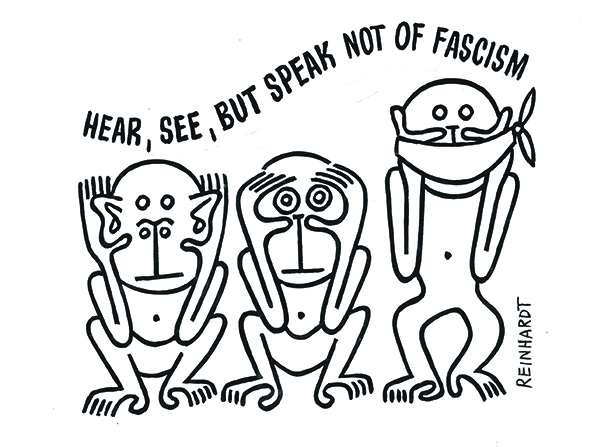Ad Reinhardt
Art vs. History
June 12–September 6, 2015
Press preview: Thursday, June 11, 11am
Opening: Thursday, June 11, 6–9pm
Malmö Konsthall
S:t Johannesgatan 7
SE-205 80 Malmö
Sweden
T +46 (0) 40 34 60 00
This is the first and largest presentation in Europe of a still largely unexamined aspect of Ad Reinhardt’s visual practice. Although the American artist is predominantly known as an abstract painter and writer, this exhibition comprises around 300 of his original political cartoons, satirical art comics and collages selected from the archives of the Ad Reinhardt Foundation, New York. These works on paper are accompanied by a slide show of digitised 35mm colour photographs by the artist, as well as a number of his travel journals, sketches and pamphlets.
Most widely known for his minimal “black” canvases of the 1960s that were revered by a roster of internationally recognised younger contemporaries such as Sol LeWitt, Frank Stella, and Joseph Kosuth, Reinhardt’s broad and singular career continues to resonate today. As the South African painter Marlene Dumas recently stated: “Anyone interested in the difference between paintings and pictures has to address Ad Reinhardt. […] Anyone who enjoys critical writing about art and appreciates irony and humour […] cannot but love Ad Reinhardt.”
While at school, Reinhardt developed an interest in cartooning: a preoccupation that became a longstanding association. He worked professionally as a graphic designer and commercial illustrator—which he maintained as distinct endeavours from that of fine artist—and he held a pivotal role in introducing styles and techniques drawn from early modernist art movements, such as Dada, Cubism and Constructivism, to these fields. He viewed these roles as completely separate (fine art, being “art-as-art,” completely dissociated from socio-political concerns; representational art, such as the cartoons, could comment upon the everyday). These roles were accompanied by a fierce commitment to social and political causes—in particular pro-labour rights and anti-war campaigns—that remained vital to his identity as an artist and a citizen.
Throughout the 1930s and 1940s, his incisive cartoons appeared in a wide range of American publications, notably the daily newspaper PM, the Marxist periodical New Masses and other magazines as diverse as Glamour, Listen, and Ice Cream Field. Inspired by the collages of Pablo Picasso and Max Ernst, some of the cartoons collaged hand-drawings with images cut from second-hand books. Reinhardt adapted this collage technique from his fine art collages, which he constructed using thinly sliced press photographs severed from daily newspapers and magazines. A number of these are featured in the exhibition.
Having studied and taught art history most of his life, Reinhardt stated in 1958: “I don’t believe in originality. I believe in art history.” Such declaration is substantiated in his celebrated and widely reproduced series, the art comics How to Look. The popular full-page series appeared in the Sunday edition of PM every two weeks throughout 1946 and served as a platform upon which Reinhardt could adamantly defend the development and understanding of abstract art in America. The comics present a didactic approach—in which Reinhardt performs the role of “explainer-entertainer”—that was directed not only at the readers, but also at his fellow artists. After securing a full-time teaching position at the Brooklyn College in 1947, Reinhardt stopped making illustrations and, thereafter, only occasionally published additional art comics in the art periodicals ARTnews, trans/formation and Art d’aujourd’hui, among others, in which he expressed his biting, satirical observations of the contemporary art world of his time.
In 1952, Reinhardt began travelling the world extensively. On various trips to Europe, Middle East, Japan and Southeast Asia he took over 12,000 colour photographs that were presented in his legendary “Non-Happenings.” These were lengthy slide-lectures that responded critically to the university tradition of teaching art history through educational slides as well as to the concurrent emergence of performative “Happenings” in the New York art scene. Reinhardt’s marathon-like presentations remixed geographies and periods in unlikely, unexpected sequences, thus shifting from art history lecture to a humorous parody of the artist’s personal travelogue. A vast array of images drawn from distant cultures would disclose analogous and playful visual patterns, such as the buttocks of statues erotically rhyming with the features of an urban fire hydrant. Their formal compositions demand the viewer’s prolonged attention, similar to the way his paintings and writings encourage an active awareness when looking at and experiencing them. Across Reinhardt’s practice, including the artworks presented here, is an ability to expand current definitions of what the aesthetic domain of art is, and can be.
This exhibition is realised in collaboration with the Ad Reinhardt Foundation, New York, and with thanks to David Zwirner, New York/London.
Curator: Diana Baldon
Biography
Ad Reinhardt (1913–67) was one of the most significant American artists of the 20th century. One of the few artists making abstract paintings in the 1930s, Reinhardt was instrumental in the development of abstract styles that became known as Abstract Expressionism throughout the 1940s and his signature monochromes of the 1950s and 1960s greatly influenced emerging minimal and conceptual practices. Reinhardt’s work was included in many important museum exhibitions during his lifetime including Americans and The Responsive Eye, the Museum of Modern Art, New York (1963–64, 1965–66); The New Decade: 35 American Painters and Sculptors, Whitney Museum of American Art, New York (1955–56); and Painting and Sculpture of a Decade: 1954–64, Tate Gallery, London (1964). In 1966, the Jewish Museum in New York mounted Reinhardt’s first major retrospective and in 1991 the Museum of Modern Art in New York organised a retrospective that travelled to the Museum of Contemporary Art, Los Angeles. Reinhardt was included in recent exhibitions at the Solomon R. Guggenheim Museum, New York (2008); the Museum of Modern Art, New York (2010–11); Kröller-Müller Museum, Otterlo (2011–12); Josef Albers Museum, Bottrop (2010–11); and the Institute of Contemporary Arts, London (2011). In 2013 David Zwirner, New York, presented an exhibition of the artist’s cartoons, photographic slides, and “black” paintings in collaboration with the Ad Reinhardt Foundation and curated by Robert Storr.


